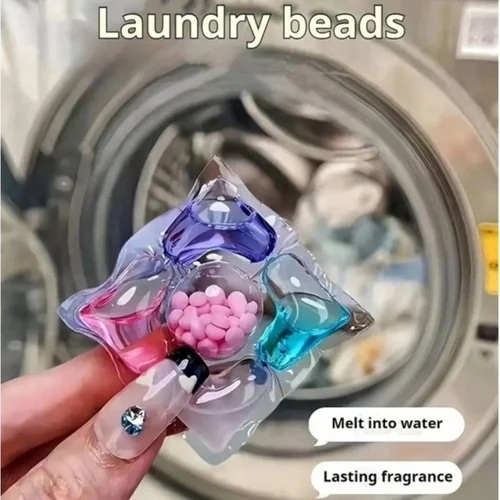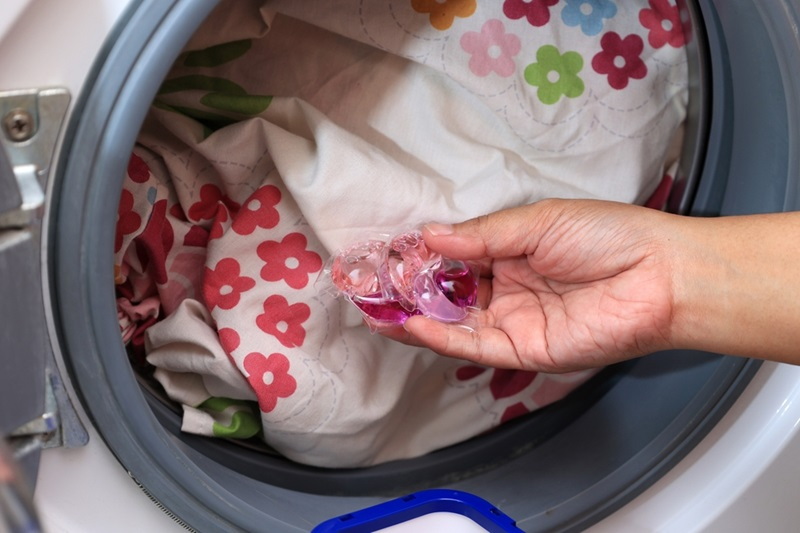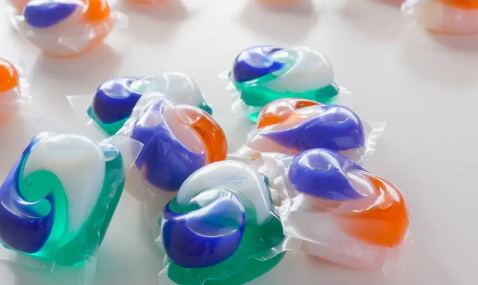Dongguan UFine Daily Chemical Co.,Ltd.
- All
- Product Name
- Product Keyword
- Product Model
- Product Summary
- Product Description
- Multi Field Search
Views: 222 Author: Tomorrow Publish Time: 10-19-2025 Origin: Site











Content Menu
● What Are Laundry Detergent Pods?
● Ingredients Used in Laundry Detergent Pods
>> Enzymes
>> Builders
● Water-Soluble Film Technology
● Manufacturing Process of Laundry Detergent Pods
>> 1. Preparation of the Detergent Formula
>> 5. Packaging
● Environmental and Safety Considerations
>> Safety
● Advantages of Laundry Detergent Pods
● FAQ
>> 1. What materials make up the film of laundry detergent pods?
>> 2. How do enzymes in detergent pods work?
>> 3. Are laundry detergent pods safe for all washing machines?
>> 4. Can laundry pods dissolve in cold water?
>> 5. What precautions should be taken when using laundry detergent pods?
Laundry detergent pods have become a popular choice for consumers seeking convenience and efficiency in their laundry routines. These small, pre-measured packets combine detergent with other cleaning agents, enclosed in a soluble film. Understanding how laundry detergent pods are made requires exploring the ingredients, manufacturing process, packaging technologies, and broader implications related to their production and use.

Laundry detergent pods are compact units containing concentrated detergent, enzymes, stain removers, and sometimes fabric softeners. These ingredients are enclosed in a water-soluble film that dissolves during the wash cycle, releasing the contents.
The pods are designed to simplify usage, prevent overdosing, and reduce product waste. Their popularity stems from ease of use, space-saving packaging, and measured cleaning power. In recent years, their usage has expanded globally, with formulation and packaging technologies being continuously refined to meet consumer demands and regulatory requirements.
The effectiveness of laundry pods depends heavily on their ingredients, which are formulated to tackle various types of stains and to protect fabrics while being environmentally considerate.
The core cleaning agents are surfactants, which lower the surface tension of water to remove dirt, oils, and stains from fabrics effectively. Common surfactants include linear alkylbenzene sulfonates (LAS) and alcohol ethoxylates (AE). These surfactants provide excellent grease-cutting and cleaning properties without damaging fabrics.
Enzymes target specific stains that typical surfactants cannot fully remove. These bio-catalysts break down complex stain molecules into smaller, water-soluble components. Protease enzymes break down protein-based stains like blood, grass, and egg. Amylase breaks down carbohydrate or starch-based stains such as sauces and baby food. Lipase targets oily and fat-based stains. The enzymatic action is optimized to work within the temperature range commonly used in household washing machines.
Builders enhance the effectiveness of surfactants by softening water and capturing metal ions like calcium and magnesium that can interfere with cleaning. Common builders in detergent pods include sodium carbonate (washing soda) and zeolites. These compounds improve overall stain removal and help maintain fabric brightness.
Polymers in detergent pods prevent dirt and grime from redepositing onto fabrics during the wash. Certain stabilizers ensure that the enzymes and surfactants remain active and effective throughout the pod's shelf life. They also maintain a stable viscosity of the liquid detergent inside the pod.
To appeal to users, manufacturers add fragrances and sometimes colorants to laundry pods. These components give a fresh scent to laundered clothes and differentiate products visually. However, their use is carefully controlled to avoid skin irritations and comply with safety regulations.
The pods are encapsulated in a film made of polyvinyl alcohol (PVA), a synthetic polymer that dissolves quickly in water but remains stable in dry conditions. PVA is chosen for its biodegradability, safety, and mechanical strength during packaging and handling.
Manufacturers experiment with film thickness, plasticizers, and modifiers to achieve an optimal balance between mechanical durability and fast dissolution in different water temperatures. The production of PVA film itself involves extrusion and drying processes ensuring uniform thickness and physical properties.
The production of detergent pods involves precise control and advanced equipment to ensure consistency, safety, and quality. The manufacturing process can be divided into several key steps:
Ingredients are carefully measured and mixed under controlled environmental conditions such as temperature and pH level to form a homogeneous liquid or gel detergent formula. This step is critical to maintain enzyme stability and ensure that surfactants and builders are fully solubilized.
Manufacturers use high-shear mixers or homogenizers to blend the components thoroughly. The formula may undergo filtration to remove any impurities or particulates before filling.
The polyvinyl alcohol films are manufactured separately, usually in large rolls. These films must meet strict quality standards for tensile strength, oxygen and moisture barrier properties, and consistent thickness ranging between 40 to 70 microns depending on the pod design.
The film is often tinted or printed with brand logos before being transferred to the pod-filling machines.
In modern production lines, filling and sealing are combined into an automated process. There are two main methods:
- Thermoforming: Heated film sheets are softened and formed into shaped cavities where detergent formula is precisely metered and deposited.
- Rotary Filling Machines: These machines use spinning mechanisms to fill pods continuously from film rolls.
Once filled, another film layer is placed on top, and heat or ultrasonic sealing is applied to create airtight, leak-proof pods. The sealing parameters must be optimized to avoid damaging the PVA film, which would compromise the pod's shelf life.
Quality assurance is a crucial step to ensure safety and performance. Pods are checked for weight uniformity, sealing integrity, and physical defects like leakage or deformations. Automated vision systems often inspect the pods, rejecting defective units.
Chemical tests may be run randomly to verify enzyme activity and detergent concentration. Stability testing simulates storage conditions to guarantee pod performance over time.
Pods are sensitive to moisture and environmental conditions; therefore, packaging must provide protection against humidity and mechanical damage. Pods are usually packed in sturdy plastic containers with tight-sealing lids or in multi-layered pouches with moisture barriers.
Packaging also contains important consumer information, including usage instructions, safety warnings, and environmental disposal guidelines. Sustainable packaging solutions are increasingly adopted by manufacturers to reduce plastic waste.

Developers of laundry detergent pods face growing pressure to make their products more eco-friendly and safer for consumers.
Manufacturers promote the use of biodegradable films like PVA that break down in wastewater treatment systems. The formulations aim to minimize the use of harsh chemicals, phosphates, and non-biodegradable substances.
Reducing the size and weight of detergents through concentration lowers transportation emissions and packaging waste. Some companies also develop refillable or recyclable containers for the pods.
Due to the concentrated nature and colorful appearance of pods, they pose ingestion risks, especially to young children and pets. Hence, safety measures in packaging design include child-resistant caps and clear hazard labeling.
Consumer education campaigns focus on proper storage and handling to avoid accidental exposure. Many countries have regulations governing detergent pod safety standards.
- Convenience: Pods eliminate the need for measuring detergent, providing a simple process for consumers.
- Consistency: Pre-measured doses guarantee uniform cleaning results without worry of overuse or underuse.
- Portability: Their compact size allows for flexible storage and minimal packaging bulk.
- Reduced Waste: Exact measurements prevent detergent waste and avoid excess chemicals entering wastewater systems.
- Improved Safety: Packaging designed for child resistance enhances household safety.
- Film Durability: Achieving the ideal film strength that withstands transport yet dissolves quickly in water remains a technical challenge.
- Ingredient Compatibility: Formulators must balance potent cleaning agents with sensitive components like enzymes that can degrade during processing.
- High Costs: Advanced manufacturing technology and high-quality materials contribute to a cost premium compared to traditional detergents.
- Consumer Misuse: Incorrect handling or accidental exposure to pods can cause safety concerns, necessitating ongoing education and packaging innovation.
Laundry detergent pods are the result of careful formulation and sophisticated manufacturing processes that combine detergents, enzymes, and other cleaning agents within a water-soluble film. Their design balances cleaning performance, user convenience, safety, and environmental concerns. The increasing popularity of pods reflects consumer demand for effective and easy-to-use laundry solutions. Continuous improvements in raw materials, film technology, and automated manufacturing processes help maintain high-quality standards. Understanding their production clarifies the advanced science and technology behind this seemingly simple household product.

Laundry detergent pods use polyvinyl alcohol (PVA) film, which dissolves in water but remains stable when dry. This film is biodegradable and safe for wastewater treatment systems.
Enzymes break down complex stains into smaller, water-soluble molecules. Protease targets protein stains, amylase digests starches, and lipase breaks down fats, enhancing overall cleaning performance.
Yes, pods are designed to be compatible with most washing machines, including high-efficiency (HE) models. However, users should always follow the washing machine manufacturer's instructions and pod usage guidelines.
Most modern laundry pods are formulated to dissolve in both hot and cold water, but dissolution rates and cleaning efficiency can vary depending on pod composition and wash cycle settings.
Pods should be kept out of reach of children and pets due to their concentrated chemicals and attractive appearance, which may pose poisoning risks. They should be stored in their original packaging with child-safe lids.